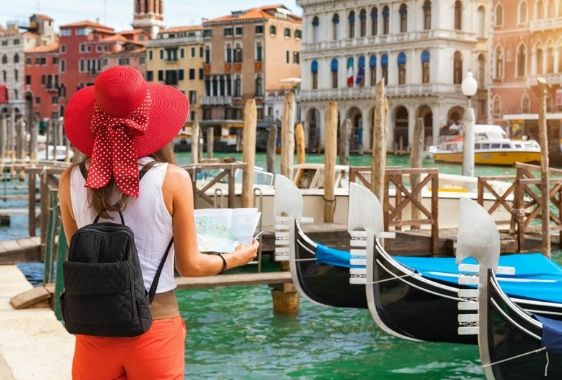Florence as we know it today, came into existence during Roman Times. From around the eighth century B.C. until 59 B.C., central Italy was ruled by the Etruscans who preferred to build their northernmost stronghold on the hill top where modern day Fiesole is located.
It was during the reign of Julius Caesar that Florence came into existence, in the year 59 B.C. he established a colony along the narrowest stretch of the Arno, which is the point where the famous "ponte vecchio" crosses the Arno. After conquering the Etruscans, the Romans established Florence as an important trading centre around the third century A.D.
In the fifth century, the peaceful and prosperous lives of these early Florentines came to an abrupt end as the Roman Empire of the West crumbled before the waves of Barbarian conquerors coming from northern Europe . The Dark Ages had begun, and with it was lost Italian unity for nearly 1400 years.
During these hard times, Charlemagne and his Frankish forces in the eighth century A.D. crushed the last of the Barbarian kings of Italy . But, this reprieve was short lived. In giving thanks, Pope Leo III made a terrible mistake that was to lead to another prolonged period of disharmony and conflict. To secure Charlemagne's loyalty, the Pope gave him the title of Holy Roman Emperor.
Most of Italy came under the rule of the Emperor, and this led to future conflicts between the Emperor and the Pope that was to drive the Italians into their own version of a civil war. The population of Florence was divided over their loyalty between the two factions. And so in Florence different factions formed, some Guelf who supported the Emperor, and some Ghibelline who followed the Pope.
Over the following centuries, control of Florence changed hands between these two groups. As blood flowed on the city streets, families built towers like the one's in San Gimignano, to provide protection from their enemies within the city. At the end of the 13th Century, with the Guelfs in control, their internal conflicts led to their demise and to the eventual end of the conflict.
Typical of the innovative skills and determination of the Tuscan's, throughout this turbulent history the region and Florence enjoyed a booming economy with a population of 100, 000. The mainstay of the local economy was the wool trade. At the end of the 14th Century, led by members of the wealthy merchant class, political life in Florence became the realm of artists and intellectuals that planted the seeds for the birth of the Renaissance.
During this period, the Medici family rose to power. As leaders of Florence , their dynasty lasted nearly 300 years. Cosimo de' Medici was a successful banker who endowed religious institutions with artworks. During the reign of his grandson Lorenzo il Magnifico, Florence was caught by an artistic and intellectual fervor that created the Renaissance movement.
After the Renaissance, a remarkably short period in time, over the following centuries Florence was ruled by a series of in-effective leaders that left Florence in the wake of the other great cities of Italy and Europe . During the re-unification of Italy in the 19th century it was made temporarily capital of Italy , until Rome finally joined the newly created Italy .
Like the tourists who visit Florence today, the city still relives those years when the likes of Michelangelo, Leonardo da Vinci, Dante, Botticelli, Donatello and many others helped change the world forever. Thankfully, the last of the Medici, Anna Maria who died in 1743, arguably gave the greatest gift to the city of Florence . In her will she bequeathed all the Medici property to the city on the agreement that they would never leave the city.









